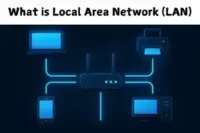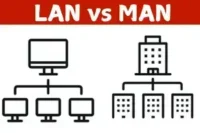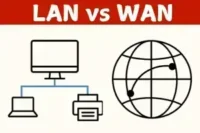What is LAN Topology?
Published: January 23, 2025
LAN (Local Area Network) refers to a network of devices like computers, printers, and other resources within a limited geographical area, such as a home or office. Topology is the layout or structure of how the devices are connected in a network. So, LAN topology describes these devices’ physical and logical arrangement in a network.
Example: In an office with 20 computers, how these computers connect (e.g., via a central hub or a shared bus) forms the LAN topology.

Why is LAN Topology Important?
The choice of LAN topology influences network performance, speed, scalability, and maintenance. Understanding LAN topology helps build a network that meets your needs, whether you run a small home network or manage a large corporate setup.
Types of LAN Topologies
Here, we break down the main types of LAN topologies:

1. Bus Topology
How it works
All devices are connected to a single cable (the bus). The data travels along the cable and is available to all devices.
Pros
Simple, cost-effective for small networks, and easy to set up.
Cons
Performance degrades as more devices are added. If the central cable fails, the entire network goes down.
2. Star Topology
How it works
Devices are connected to a central hub or switch. The hub acts as a mediator that manages data flow.
Pros
Easy to expand, central point for management and troubleshooting, better performance.
Cons
Hub failure leads to a network breakdown, requiring a redundant setup for more extensive networks.
3. Ring Topology
How it works
Devices are connected in a closed loop. Data travels in one direction around the ring until it reaches the destination.
Pros
Balanced data load and predictable performance.
Cons
A failure in the loop can disrupt the entire network, and adding devices can be complex.
4. Mesh Topology
How it works
Each device is connected to every other device in the network. It creates multiple paths for data transmission.
Pros
Very reliable, data can be rerouted if one connection fails.
Cons
It is expensive and complex to set up due to the need for extra cables and hardware.
5. Hybrid Topology
How it works
A combination of two or more different topologies in one network. For example, a star-ring combination.
Pros
Offers flexibility, scalability, and fault tolerance.
Cons
More complex to manage and costly.
Factors to Consider When Choosing a LAN Topology
When selecting the best LAN topology, several factors must be considered:
Network Size and Scale
Small networks may only require bus or star topologies, but larger networks need more scalable and reliable options, such as mesh or hybrid topologies.
Cost and Budget
Some topologies, like star and mesh, are more expensive because they require additional hardware (hubs, switches, cables).
Reliability and Fault Tolerance
Mesh topology is highly fault-tolerant, as data can be rerouted if a device or cable fails, while bus topology has a single point of failure (the central cable).
Ease of Maintenance
Star topology is easier to maintain since issues are isolated to individual connections and can be traced through the central hub.
Choosing the Right LAN Topology for Your Network
Here’s how to choose the best topology based on your needs:
1. For Small Networks
Best Choice
Bus or Star topology. These are simple and cost-effective options for a small office or home network.
2. For Large Networks
Best Choice
Star, Mesh, or Hybrid topologies are more scalable and offer better performance for larger businesses or offices.
3. For High Availability and Redundancy
Best Choice
Mesh topology ensures that data can travel even if one connection fails.
Common Issues in LAN Topologies and How to Solve Them
Discuss some common issues and troubleshooting methods:
1. Performance Issues
Overcrowding in bus topology can lead to slower speeds.
Solution
Use star topology for better performance.
2. Faults and Failures
If a hub in star topology fails, the whole network can be affected.
Solution
Use a redundant hub or dual connections for better reliability.
3. Expanding the Network
Expanding a bus topology can be difficult.
Solution
Consider switching to star or mesh topology for easier expansion.
You may also like these posts:
Advantages and Disadvantages of LAN
Conclusion
The right choice of LAN topology depends on network size, cost, and reliability needs. Choose a topology based on your network requirements, whether you need flexibility, scalability, or redundancy.
FAQs about LAN Topology
LAN topology refers to the physical and logical layout of devices in a network, showing how they are connected.
The topology affects network performance, reliability, and scalability. It helps in planning how devices are linked together efficiently.
Star topology is often the best choice for small businesses as it’s easy to set up and manage, with minimal disruption if one device fails.
In bus topology, all devices share a single cable, while in star topology, each device connects to a central hub, improving performance and troubleshooting.
The most reliable mesh topology is one in which each device is connected to every other device, allowing for multiple paths for data.
Expanding a network depends on its topology. Devices can easily be added to the Star topology by connecting them to the central hub or switch.
Combining topologies, such as hybrid topology, to suit specific needs offers flexibility and scalability.
If the hub fails, the entire network will go down since all devices depend on it for communication.
Bus topology is the most cost-effective because it uses a single central cable for all devices, requiring fewer components.
Mesh topology offers fault tolerance because if one connection fails, data can still be sent through other available paths, ensuring continuous communication.
To set up a Local Area Network (LAN) in Minecraft, host a game on your computer, open the game to LAN under the “Pause” menu, and share your IP address with friends to connect using the “Direct Connect” option. Both players need to be on the same network or use VPN software.
In LAN topology, backbone cables interconnect different devices or segments, creating a central communication path that helps maintain network efficiency.





